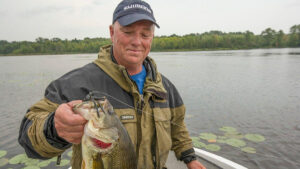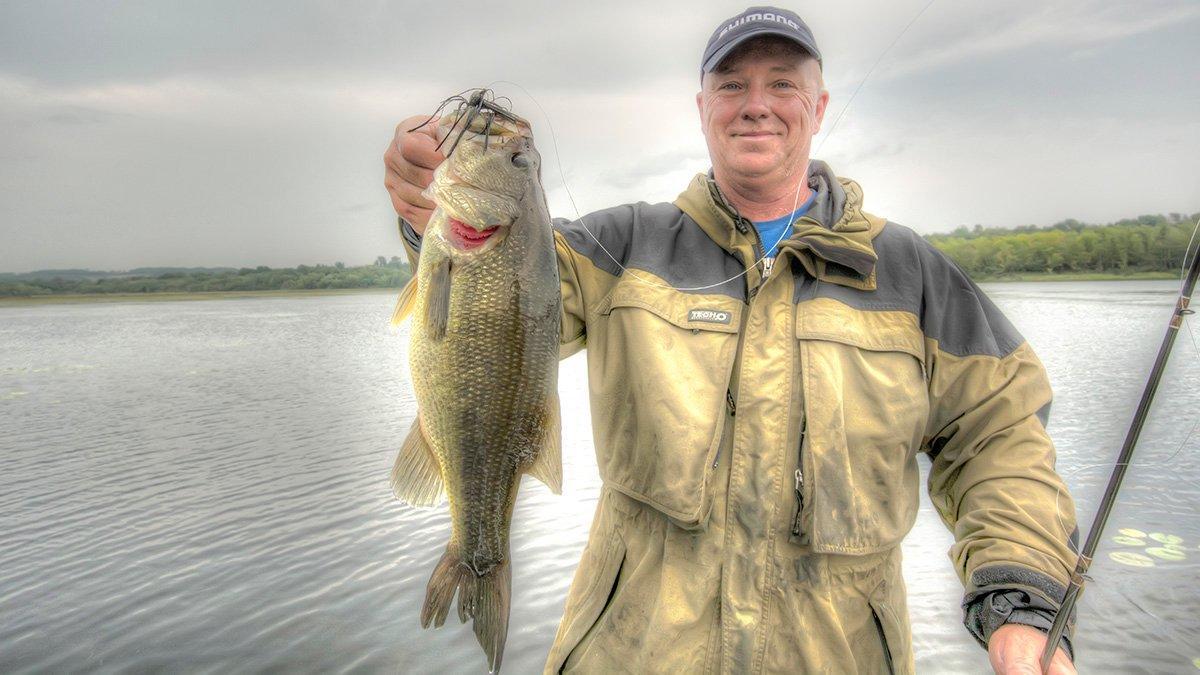When fall arrives, northern river largemouth bass leave shallow, fertile bays and move to main-river habitat. Bass hold on shoreline wood, grass flats, deep rocky current breaks and points found near bay mouths. Flipping jigs, big Texas-rigged plastics, spinnerbaits, jerkbaits and crankbaits all catch big, hungry fall largemouth from rivers.
“In late September to early October, largemouth bass make a mass exodus out of bays and hold tight to the transition area between the slack water of the bay mouth and the river current,” said Rick Klatt, who’s house sits on the shore of the Ottawa River. Klatt’s spent more than four decades fishing the river for pleasure and competitively in tournaments.
“Fall can be the best fishing of the year. It’s a real bonanza.”
The following 3 sections breakdown where to find and catch big largemouth bass from rivers in the fall.
- Cool temps kick-out bass
- Where they go
- Baits and tactics
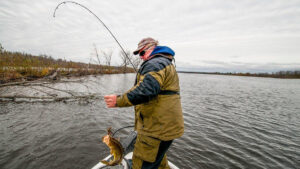
Cool temps mean change
Seasonal cues prompt largemouth bass to leave shallow bays in fall. As water cools in late September and early October, largemouth, along with northern pike, panfish and baitfish, transition from shallow bays. “It’s a mass exodus,” Klatt said.
There is more to a largemouth’s departure from shallow bays than following food and avoiding chilly water. Wintering in bays across the ice belt can be deadly. Thick ice can lock bass into backwater areas. Winter kill occurs when oxygen levels drop to lethal lows. Bass instinctually seem to know to flee shallow bays in autumn.
There are exceptions. Massive backwaters containing deep water and current carrying oxygen are more hospitable. Largemouth may stick around come ice.
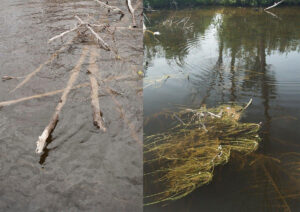
Where they go
Largemouth leaving bays travel no further than needed to stay close to food and cover. In early fall, Klatt catches bass from the transition zone between the slack water of a bay mouth and the main river current. Grass lines, rocks, timber, sand bars and points located within this zone hold largemouth.
“Most of the largemouth leave the large spawning bays and swim upstream,” Klatt said. “These fish will position themselves close to the bay mouth for weeks and slowly advance upstream.”
Largemouth stay in these areas, eating panfish and minnows. They linger near bay mouths initially to follow bait should it returns within a bay. This can happen during mild spells in early autumn.
As October draws to a close and water temperatures plummet, largemouth move further from bays. Rocks in current become prime habitat.
“Fish now have moved some distance from the bay mouths and have positioned near current breaks close to deeper water,” Klatt said. “I believe they’re moving to their wintering habitats and also following the baitfish. The fish seem to tuck themselves tight to the rock and near bottom along a sharp drop off anywhere from 6 to 12 feet of water and will face upstream to ambush whatever comes over the rocks.”
River bass also love timber. Wood buffers current, offers cover and provides an ambush spot. Beaver dams, log jams, stumps, standing tree trunks and laydowns are all hideouts for giant largemouth in the fall.
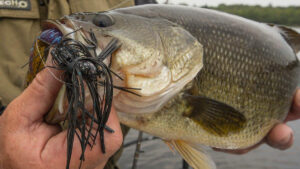
Baits and tactics
Leap-frogging river spots demands assorted lures for different structure and cover. For instance, Klatt may fan cast a spinnerbait over a grass line, while moving upstream towards a fallen tree. Once at the wood, he’ll dissect the timber with a flipping jig or bulky plastic. But, he sticks with these 6 reliable lures for largemouth in fall in rivers.
- Spinnerbaits
- Flipping jigs
- Creatures
- Soft stickbaits
- Jerkbaits
- Crankbaits
Spinnerbaits
A tandem, 1/2-ounce spinnerbait tops Klatt’s bait lineup for fall river bass. Moderate winds and a slight chop are primetime for chuckin’ and windin’. Grass flats, bay mouths and sand-rock areas are spinnerbaiting territory.
“I have been successful going with the wind and current and covering literally miles of water,” Klatt said. “In good areas, or where there are numbers of fish, I will swing back up into the current and fish more thoroughly usually with a jig or stick bait.”
Spinnerbaits work later in fall, but slow retrieves are the norm. Use a heavier model for deeper bass.
Klatt’s mainly fishes white spinnerbait skirts mixed with chartreuse, red and metallic strands. Silver blades are preferred when it’s sunny, gold blades when overcast. A 7-foot medium-heavy castin rod with 20-pound Berkley Trilene Big Game is the norm on rivers.
Flipping jigs and creatures
Klatt likes a 1/2-ounce Lunker Lure Triple Rattleback flipping jig. Black, black-blue and brown top the color list.
Gambler Ugly Otters, Reaction Innovation Sweet Beavers and other 5 inch creature baits are also flipped and pitched to cover.
To dissect standing timber or fallen trees, begin downstream and use the electric motor to creep towards the cover. This provides better boat control and more precise tactics than drifting downstream.
Flipping jigs and creature baits are tied to 50-pound Tuf-Line braid for heavy cover and timber. He will drop to 25-pound Seaguar fluorocarbon if fish get fussy or in lighter cover.
Soft stickbaits
The fast-sinking 6-inch Bass Magnet Quiver Daddy’s another good choice. It’s Texas rigged on a Trokar Magworm 5/0 wide-gap hook and fished on 20-pound mono and a 7-foot, 6-inch medium-heavy casting rod. This stickbait slides through cover with ease. Black and blue is a reliable on most rivers.
Klatt casts upstream and perpendicular to a grass edge. The stickbait quivers temptingly while sinking in current. When it touches cover, Klatt raises it a few feet. Then it glides and drops again.
The Quiver Daddy’s also pitched ahead of wood cover on a 45-degree angle. Then covertly drifted under laydowns and flooded timber.
Jerkbaits and crankbaits
While a spinnerbait buff, Klatt uses hard baits more as fall progresses. Rapala X-Raps and Shadow Raps retrieved on a twitch-and-pause pattern work well. A hot pink jerkbait stands out in dingy river water, helping bass locate the lure.
Crankbaits with a tight wobbling action are equally deadly for bass in fall. River anglers should have a selection of crankbaits for different depths. Klatt finds 4 to 6-foot runners work well in early fall, while 8 to 12-foot diving cranks later in the season.
Casting a square-bill crank around timber’s another effective tactic. Making the lure hit the wood gets a bass’ attention and triggers reaction strikes.
Klatt presents hard baits on Tuf-line 15-pound braid with a 10 or 12-pound Sunline fluorocarbon leader with a 7-foot to 7-foot, 2-inch medium spinning rod.
Rivers are often said to be underutilized by anglers. Nowhere is this more true than during cold water. Don’t ignore these bass factories this fall. Locate shallow, spawning bays and look upstream for trees, grass and rocks where largemouth stack-up after leaving shallow bays. Bring a handful of Klatt’s top baits and you can bet you’ll be posing for a photo with a brace of fat largemouth from your favorite river this fall.
